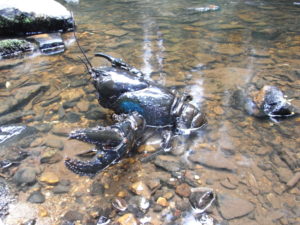What is the giant freshwater crayfish?
The giant freshwater crayfish (Astacopsis gouldi) is the largest freshwater invertebrate in the world. These native Tasmanian crayfish are bigger than any found in the Amazon, the Congo or the Mississippi! The giant freshwater crayfish is also often called the giant freshwater lobster, but lobster usually refers to marine species. Here are some pictures of giant freshwater crayfish. A big thank you goes to the world renowned expert on their ecology, Todd Walsh, who provided these pictures.


Where does the giant freshwater crayfish live?
The giant freshwater crayfish is found only in northern Tasmania, in the rivers and creeks that flow towards Bass Strait (click here to see the interactive distribution map in the Atlas of Living Australia). Historically, its range extended from the Arthur River catchment in the west to the Ringarooma River in the East. Today, its eastern populations are fragmented and much lower than in the west. It is not found in the Tamar river catchment. It is only found at altitudes below 400 metres, and so is restricted to the coastal plain and just the foothills of northern Tasmania’s mountains.

How big are giant freshwater crayfish?
They can grow to be really big! There are historical reports of giant freshwater crayfish that weighed up to 6 kilograms and were almost a metre in length. These days, large individuals weigh about 2-3 kilograms and up to around 80 cm in length. The average weight is about 500 grams.
How long do giant freshwater crayfish live?
This is actually a hard question to answer. They are a very slow growing animal and it is thought that they can live for 80 years or more. The exact age of a crayfish is difficult to know because they moult regularly (once or twice a year), each time growing a new exoskeleton. So you can’t tag and release an individual and follow it over a long period. Scientists have been trying for many years to work out a direct way to determine the age of crustaceans and some recent Australian research holds promise in this area. Unfortunately, this technique requires the animal to be sacrificed and would have to be calibrated on each species. Currently, the age of live crayfish can only be estimated based on size. This is routinely done by measuring the length of their carapace -the part of their exoskeleton that extends backwards from their head and protects their upper body.
What do giant freshwater crayfish eat?
Mostly they eat decaying leaves, wood and other plant matter that falls into the streams. They also eat small fish, insects and scavenge rotting animal flesh.
What animals eat giant freshwater crayfish?
If they get to be adults, nothing except for humans! However, juveniles are preyed on by platypuses, rakali (native water rats), large fish and other crayfish.
Is the giant freshwater crayfish threatened, vulnerable or endangered?
Depends who you ask. It is listed as vulnerable under both the Federal Environment Protection and Biodiversity Conservation Act (1999) and the Tasmanian Threatened Species Protection Act (1995). However, it is classified internationally as endangered on the IUCN Red list. Whichever way you look at it, the giant freshwater crayfish is in trouble. Populations are low and fragmented and it lives in a very limited geographical area.
Why is the giant freshwater crayfish threatened?
The two main threats are habitat loss and illegal fishing. The giant freshwater crayfish needs cool clear water to live in, so, removal of trees along streams is a big problem. The tree canopy provides shade to keep the water cold and the plant material that they eat. Clearing also causes soil runoff into streams which clouds the water with particles of sediment. This exposes juveniles to predators, because it fills up the holes and crevices that they need to hide in. Fine sediment also makes it hard for crayfish to get oxygen, as it blocks their feathery gills. Fishing for the giant freshwater crayfish was completely banned in 1998. Prior to this fishing was banned on some rivers and allowed on others. This was found to be ineffective, with overfishing just as common on the protected rivers as elsewhere. Sadly, despite almost 20 years of complete protection, illegal fishing is still a big problem.
